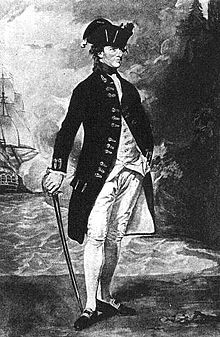Hyde Parker (admiral)
| Sir Hyde Parker | |
|---|---|

Admiral Sir Hyde Parker (1739–1807) after the painting by Romney
|
|
| Born | 1739 |
| Died | 1807 |
| Allegiance |
|
| Service/branch |
|
| Rank | Admiral |
| Commands held |
Leeward Islands Station Jamaica Station |
| Battles/wars |
American Revolutionary War French Revolutionary Wars Napoleonic Wars |
Sir Hyde Parker (1739 – 16 March 1807) was an admiral of the British Royal Navy.
He was born in Devonshire, England, the second son of Admiral Sir Hyde Parker, 5th Baronet (1714–1782). He entered the Royal Navy at an early age, and became lieutenant on 25 January 1758, having passed most of his early service in his father's ships. On 16 December 1762 was promoted to command the Manila, from which, on 18 July 1763, he was posted to the Baleine.
From 1766 onwards for many years he served in the West Indies and in North American waters, particularly distinguishing himself in breaking the defences of the North River at New York in 1776. His services on this occasion earned him a knighthood in 1779. In 1778 he was engaged in the Savannah expedition, and in the following year his ship was wrecked on the hostile Cuban coast. His men, however, entrenched themselves, and were in the end brought off safely. He became commander-in-chief of the Leeward Islands Station in 1779.
Parker was with his father at the Battle of Dogger Bank, and with Richard Howe in the two actions in the Straits of Gibraltar. He reached flag rank on 1 February 1793, the same day that war was declared against the new French Republic. As Rear Admiral, he served under Samuel Hood at Toulon and in Corsica. He was promoted to Vice-Admiral on 4 July 1794 and took part, under The Lord Hotham, in the indecisive fleet actions on 13 March 1795 and 13 July 1795. From 1796 to 1800 he was in command at the Jamaica Station and ably conducted the operations in the West Indies.
...
Wikipedia
